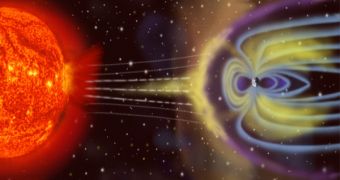Based on the historic accounts of the devastation the large 1859 solar storm did in its time, the National Academy of Sciences (NAS) released a new report recently that makes us draw terrifying conclusions about the aftermath of a potential solar storm hitting the Earth and passing through the magnetic defenses our planet employs. The destruction would be far more widespread than it was 150 years ago and could potentially threaten the governmental control over the population.
"A contemporary repetition of the [1859] event would cause significantly more extensive (and possibly catastrophic) social and economic disruptions," the report reads.
"Space weather can produce solar storm electromagnetic fields that induce extreme currents in wires, disrupting power lines, causing wide-spread blackouts and affecting communication cables that support the Internet. Severe space weather also produces solar energetic particles and the dislocation of the Earth's radiation belts, which can damage satellites used for commercial communications, global positioning and weather forecasting."
It goes on to say that "Impacts would be felt on interdependent infrastructures with, for example, potable water distribution affected within several hours; perishable foods and medications lost in 12-24 hours; immediate or eventual loss of heating/air conditioning, sewage disposal, phone service, transportation, fuel resupply and so on."
A rough estimate says that some 130 million American citizens could be left without electricity – and all the benefits that come with it – as well as face the prospect that reparations could take months to complete, during which time the country would be virtually crippled and unable to perform even routine commercial trade. Defense installations could also be affected, as transformers and generators would be fried on account of the solar storm.
"Emergency services would be strained, and command and control might be lost. Whether it is terrestrial catastrophes or extreme space weather incidents, the results can be devastating to modern societies that depend in a myriad of ways on advanced technological systems," University of Colorado Laboratory for Atmospheric and Space Physics director Daniel Baker, the leader of the study that yielded the report, said in a statement.

 14 DAY TRIAL //
14 DAY TRIAL //